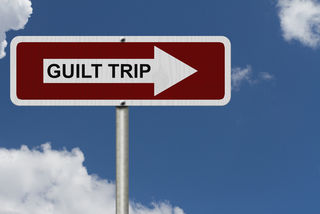
Guilt
Ridding Happiness Contaminants: Guilt
You may damn your sin, but never yourself
Posted January 12, 2016

The great American humorist, Erma Bombeck, once wrote, ”Guilt is the gift that keeps on giving.” How true. Many people carry guilt with them over some misdeed acted out decades before all the way to the grave. Still others experience multiple episodes of guilt over any number of errors and mistakes that dotted the fabric of their entire lives. The emotional pain these people carry is palpable, significantly affects the quality of their lives, and blocks their possibility for happiness.
Even worse, many people believe that guilt is an appropriate and necessary way to feel once one engages in some wrongdoing. To not feel guilt would render one a sociopath, their reasoning goes. Moreover, they avidly promote guilt, with the argument that it is one of the controls necessary for society to function in a civilized way. Accordingly, one hears hellfire and brimstone preached from far too many pulpits, classroom lecterns, and dining room tables.
As a practicing clinical psychologist, I assert that guilt is neither personally useful nor societally beneficial. It derives from flawed thinking, destroys human happiness, and it is not needed for a person to modulate his or her behavior to conform to society’s norms. I have devoted my professional life to helping people give up their guilt so that they can live happiness-filled, responsible, and productive lives. That is what I want for you as well, dear reader.
So, please read on to understand the dynamics of guilt and what you can do to eliminate it from your life. If you adopt what follows into the way you think, you can eliminate this happiness-contaminant and get on with the business of being happy and productive, both within yourself and within the context of the social structure you inhabit.
The ABC's Of Guilt
The great American psychologist, Albert Ellis, supported by literally thousands of research studies, has taught us that guilt does not result from a person erring, making mistakes, or engaging in some kind of egregious act. Rather, it comes from damning oneself for doing so.
We who do Rational Emotive Behavior Therapy (REBT) organize this into a simple, rememberable ABC model. In this model, A, the Activating Event, represents the wrong thing the person did. B, the Belief, is how the judges himself or herself, having thus acted in the wrongful way. C is then the Emotional Consequence, the resulting feeling of guilt derived from the self-damning at B. So, it is not the act itself (the A) that causes one to feel guilty (the C), but the negative thinking one does about oneself (the B) about the act.
Let me concretize this with a clinical example. Ten years before forty-seven year-old Sherry walked into my office, she suffered from a very severe Anxiety Disorder characterized by intense general anxiety, frequent panic attacks, and an aversion to leaving her home that bordered on agoraphobia. Out of desperation, she consulted with a counselor who provided comfort, empathy, and support. The rub was that he eventually cajoled her into taking car rides with him and eventually seduced her into a motel room where he had sex with her. The guilt she carried for the whole of this last decade caused her to seek my services.
As unsavory and unethical as were the actions of the counselor in this case, Sherry's guilt followed perfectly the ABC model, as follows:
At A, the Activating Event: Sherry trusted this unethical counselor and agreed to be intimate with him.
At B, the Beliefs she processed about what she did was –
(1) I made a mistake.
(2) I wish I had not done that and been stronger.
(3) It was horrible what I did and I shouldn’t have done that.
(4) I’m a bad, bad person for doing what I did.
Then, at C, the Emotional Consequence, she experienced crippling guilt.
To repeat, what is noteworthy in this example is that it was not the mistake she made at A that caused her to find her guilt at C. Rather, it was the self-damning thinking she did at B that did it to her. And, thankfully so, I say. Why? Because what happened to her, including what she did, is forever written in the sands of time. But, this is not so for her self-damning thinking. This thinking was available for analysis and thus open for reframing.
And that's what we did over the course of her next five psychotherapy sessions. We took each of her beliefs at B, held them up to rigorous scrutiny, and destroyed their validity, one by one. We in REBT call this Disputation, the D in the therapeutic process.
The D Of Ridding Guilt
Let's first take a look, in shorthand, at the reasoning as Sherry and I employed as we Disputed, Debated, or Debunked each of her guilt-producing Beliefs at B. See what you, dear reader, can learn from this. The question to keep in mind as we tackle each belief is: “Is this belief true or valid?”
B1 – I made a mistake. This belief could be either true or not, depending on how you look at it. Some therapists would focus on convincing Sherry that it is not true that she made a mistake. Why? Well, because she was, at the time, a very troubled person, suffering severe anxiety, being extremely vulnerable, and in no way capable of using good judgment. So, for her to hold herself responsible for her actions stretched credulity to its limits. If anybody did wrong, it was this spurious counselor who took advantage of this hapless, helpless waif.
At the beginning of Sherry’s Disputation process, I strongly advocated this reasoning, which, to a large extent, is logically sound and empirically valid. At first, Sherry fought this way of thinking, insisting that she had indeed done something grievously wrong and thus deserved to feel guilty. But, I gradually wore her down with logic and evidence until she was able to honestly say, “I was in such a state that I hardly had any choice in the matter.”
By changing her thinking as she did, Sherry felt a tremendous lifting of her guilt. Some therapists would have stopped her therapy right there. But, not me, an REBTer. I had more fish to fry. I not only wanted to help her relinquish her guilt about this particular incident, but I also wanted her to change the basic self-damning paradigms underlying the way she thought about this particular incident. I wanted her to never again feel guilty about anything in the future. So, we went on to her other B’s, below.
B2 – I wish I had been stronger and not done that. I encouraged her to keep this belief as valid. Why? Because it's true. She had a solid ethical and moral standard, and it logically followed that she would want to act according to her own values, if at all possible, in all future situations. This statement, then, represented a true, valid expression of her values and would, incidentally, motivate her to do her best to act accordingly in the future.
B3 – It was horrible what I did and I shouldn't have done it. This Belief gets to the heart of the guilt matter. Whether having acted badly at A or not, no person should leave a therapy session without debunking this belief.
First, what she did was not horrible. Even if she had decided that she indeed acted badly, which is debatable, what she did hardly rose to the level of a horror, as does such atrocities as genocide, the raping of children, or a nuclear holocaust. All things being equal, it was a relatively innocuous thing she did, even if it was wrong.
Second, it is absurd for her to think that she shouldn't have erred. For, after all, she's demanding perfection of herself, expecting herself to never error, act weak, or use bad judgment, no matter the circumstances. Nonsense. She is, at the core, a fallible human being who could reasonably expect herself to error on occasion. Added to that was the fact that she was in an extremely vulnerable and emotional state in which cloudy thinking, bad judgment, and impulsive decisions were likely.
Third, if Sherry were thinking like a scientist, instead of out of strong emotion, she would realize that, in a cause-and-effect way, she should have acted exactly as she did. By using the word “should” just now, I don't mean it in the sense of desirable or good, but in the sense that, given all the conditions that were present, it was highly predictable she would act as she did.
B4 – I’m a bad, bad person for acting as I did. This belief put the final nail in the coffin of Sherry’s guilt. Notice that, by thinking this way, Sherry moved from damning what she did (“I did wrong and I wished I hadn't.”) to damning herself (“I’m a bad person.”).
Self-damning, the quintessence of guilt, never make sense. Quite simply, this thought is an overgeneralization in that it took one bad deed and colored her whole self and her whole life, past and present and future, as bad by virtue of this one deed. This is like throwing a whole bushel of apples out because one is rotten. Clearly Sherry was much more than this one act, with most all of her other actions being good and proper, throughout the whole of her life.
By our fourth session, Sherry got into the swing of her REBT Disputation. As time went on, she took an active part in this process, getting better and better at rationally thinking through her beliefs so that she could get clearer and clearer about their absurdity. All this took us to the final step in her therapy, the E, below.
The E Of Ridding Guilt
E stands for the new Effective Thinking. The goal of psychotherapy is for a person to indoctrinate himself or herself with more valid, effective thinking, both toward to the event under consideration and to all such events in the future. For Sherry, if I may paraphrase, her new effective thinking went something like the following:
“I sure hate that I had to go through that experience.But, I did no wrong, as I was too troubled and vulnerable to have done better than I did. It was about him, not me. But, even if I did error, using bad judgment, I'm fallible and human, hardly a bad person for acting on this one occasion. Furthermore, I can learn from it for future use and get on with the process of a leading a happy, productive life.”
Notice in this E that Sherry claims the best of both worlds. She retains her moral and ethical values, which will predictably lead to her doing her best to act responsibly in the future. At the same time, she refused to damn herself, thus eliminating her guilt.
What About You?
Like Sherry, you need not contaminate your happiness with guilt. How about adopting the same Effective Thinking Sherry did. You could start off each morning grounding yourself in the same thinking she adopted through her therapy process, being sure to live it each and every day.
Also you could work yourself through the ABCDE process Sherry did whenever you feel guilt. It will work for you, just like it did for her, as your guilt comes from the same kind of irrational thinking hers did, no matter what the mistake you made at A. And, don't hesitate to contact a competent cognitive-behavioral therapist, preferably a REBT one, if you find a need for help in the process.
Going Forward
It is my hope that you have found this blog useful in your quest for happiness. Till next month, then, live healthy and with passion.
Russell Grieger, Ph.D. is a licensed clinical psychologist in private practice in Charlottesville, Virginia. The author of several self-help books, all designed to empower people to create a life they love to live, he invites you to check out his new relationship happiness book, The Couples Therapy Companion; A Cognitive Behavior Workbook. You may contact Dr. Grieger for questions or for more information at grieger@cstone.net



